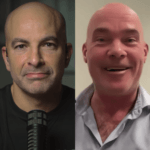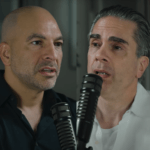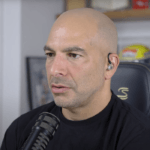Lloyd Klickstein is the Chief Science Officer at resTORbio, a biopharmaceutical company that develops medications to target the biology of aging. In this episode, Lloyd discusses his company’s clinical application of rapamycin and its derivatives. He also elucidates details of his 2014 paper—a paper that greatly influenced Peter’s perspective of rapamycin in the context of longevity. Peter and Lloyd go on to discuss the dose-dependent effect of rapamycin on immune function and compare rapamycin, fasting, and caloric restriction.
Subscribe on: APPLE PODCASTS | RSS | GOOGLE | OVERCAST | STITCHER
We discuss:
- His background and decision to leave academia for translational medicine [6:15];
- Translational medicine—bridging the gap between basic science and clinical medicine [10:30];
- What prompted Lloyd to focus on mTOR inhibition? [18:00];
- Defining mTOR, TORC1, and TORC2, and the consequences of inhibiting them with rapamycin [21:30];
- Dose-dependent impact of rapamycin on immune function, mTOR inhibition, and toxicity [42:15];
- Lloyd’s 2014 experiment—mTOR inhibition improves immune function in the elderly [53:00];
- Insights into autophagy, antigen presentation, and the pleiotropic benefits of a rapalog, and how it compares to fasting [1:13:00];
- Lloyd’s 2018 experiment—TORC1 inhibition enhances immune function and reduces infections in the elderly [1:18:45];
- Creation of resTORbio, subsequent studies, and takeaways about dosing, TORC2 inhibition, and tissue selectivity [1:29:00];
- Comparing the longevity effect of rapamycin, fasting, and caloric restriction [1:40:00];
- Excitement around RTB101—resTORbio’s mTOR inhibiting molecule [1:47:00];
- Identifying rapalogs selective for TORC1 [1:56:15];
- Treating depression with ketamine, an activator of mTOR [2:00:00];
- Epigenetic clocks, rapalogs, and metformin [2:03:30]; and
- More.
His background and decision to leave academia for translational medicine [6:15]
- Science and medicine is the family business
- He did the combined MD, PhD track at Harvard
When did you decide you wanted to focus on immunology, rheumatology?
- “Like many things in life it was about the people, not the science that led me into immunology, rheumatology and where I am.”
- He credits his time in a laboratory at Brigham and Women’s Hospital and meeting such wonderful people that ultimately his decision was to stay there and work and learn with them
- He earned his M.D., Ph.D, in 1989
- He then completed postgraduate clinical training in Internal Medicine, Rheumatology & Immunology at Brigham & Women’s Hospital (BWH) in Boston stayed there until 2006
- In 2006, he left academia to join Tim Wright‘s department at Novartis Institutes
Basis for leaving academia?
“For me it’s important to do both science and medicine, and it’s harder and harder and harder to do that now in an academic environment.”
- Within the academic environment, you have many obligations to research, finding grants, and teaching student — “It’s sort of amazing to me that some folks can actually straddle that.”
- Translational medicine, which was a new concept at the turn of the millenia, “was perfect for somebody like me”
Translational medicine—bridging the gap between basic science and clinical medicine [10:30]
Basic science
-One example of basic science that led to a Nobel Prize is the study of restriction enzymes
- This came from studying obscure bacteria and how they limit their infection by viruses which got to the concept of restriction enzymes—which was required for the development of modern molecular biology
-Another example is CRISPR technology
- It is another critical element of the bacterial immune system—It’s simple, elegant, and powerful
- It came from studying bacterial biology and it became exciting when somebody translated the biochemistry in the bacteria to see if it would it work in humans (which it did)
- See work from Jennifer Doudna
–The takeaway: Basic science isn’t necessarily in pursuit of anything beyond knowledge, and it doesn’t come with this need to have a clinical application with respect to the species of interest
Clinical medicine
- Medicine is the science and practice of establishing the diagnosis, prognosis, treatment, and prevention of disease [wikipedia.org]
- Investigating things like: Does taking this medication lower your risk of a stroke? Does taking this vaccine lower your risk of getting the flu?
Translational medicine
- There’s a big gap between basic science and clinical medicine—and translational medicine bridges that gap …
{end of show notes preview}

Lloyd Klickstein M.D., Ph.D.
Dr. Klickstein is Chief Scientific Officer of resTORbio. Prior to joining resTORbio, Dr. Klickstein was Head of Translational Medicine for the New Indication Discovery Unit (NIDU) and the Exploratory Disease Area (DAx) at Novartis Institutes for Biomedical Research. Under his decade of leadership, NIDU & DAx teams carried multiple projects forward from target identification through clinical proof-of-concept in novel areas of drug development including liver disease, hearing loss and aging, among others. Prior to his 13 years at Novartis, Dr. Klickstein was an academic physician-scientist at Brigham & Women’s Hospital (BWH) in Boston, where he directed an NIH-funded basic research laboratory and maintained an active clinical practice in the Arthritis Center. Dr. Klickstein received his B.S. degree from Tufts University, his M.D. and Ph.D. degrees from Harvard University, completed post-graduate clinical training in Internal Medicine, Rheumatology & Immunology at BWH and a post-doctoral research fellowship at the Center for Blood Research in Boston.






I’ve read about rapamycin and rapalogues used agaisnt B-cell lymphoma. Have they ever been tested in T-cell lymphomas? I have a dog with T-cell lymphoma, is there a research team out there studying this possibility and that I could contact? Thank you!
Amazing Podcast. A couple of questions?
– Did they determine optimal therapeutic dose to inhibit most side effects namely aphthous ulcers and why are they so common?
– Does intermittent dosing effect use in Tumor suppression with hyperactive mTORC1 signaling, ie. SEGA or Angiomyolipoma?
-Do they know long term side effects of down regulation of TORC2 in continuous chronic treatment? not months/ years?
-My last dumb question if ultimately we are suppressing MTORC. How does Rapamyacin inhibit growth? Is that the MTORC 1 suppression and/or does it “gather up” cellular senescence and activate autophagy?
Also, any info on this study and drug DL001? https://rdcu.be/b5upT
All of this is way above my ability to fully understand but I appreciate you sharing in a non-condescending format. Keep up the great work.
DJ: They did get a preliminary answer to this — see the show notes:
“Mouth ulceration—the most common side effect of rapamycin/rapalogs
11.5% of the 0.5 mg daily
4%, of the 5 mg weekly
17% of the 20 mg weekly”
But no: no work has been done to narrow this down even further, and individuals probably vary significantly in susceptibility: trial and error is the watchword.
Do you have any recommendations for those who would like to consider an “N of 1 trial” of rapamycin?
Follow up question: can you point toward any literature regarding how to incorporate fasting and resistance training into a regiment with a weekly dose of rapamycin?
In all of his interviews on mTOR, when he asks about the effects of chronic vs. intermittent inhibition, Peter seems to have forgotten that rapa was administered every single day in the original 2009 Nature paper and all the subsequent ITP publications, and nearly all the other rodent lifespan studies. Intermittent dosing has really only been used in small, underpowered pilot studies:
https://dx.doi.org/10.1093/gerona/glw064
https://dx.doi.org/10.1111/acel.12405
Note that both of these papers are reports from the same single study. Note that it included females only, had no chronic treatment comparison group, and only 20 mice per group where you really need more like 50 for a robust lifespan study. Nominally, the effect size was similar to what was seen with chronic dosing in females in the 2009 ITP paper.
And that’s just about it! There’s also Kaeberlein’s dog study, and this, which is transient high-dose chronic rather than true intermittent dosing:
https://dx.doi.org/10.7554/eLife.16351.001
… and this, which didn’t look at lifespan:
https://dx.doi.org/10.1093/gerona/glx249
There’s also the Novartis/resTOR bio Science: Translational Medicine trials, of course, but those didn’t measure lifespan or broader aging effects beyond immune function.
Peter keeps saying that CR stops working in older rodents. This is an old myth that got going based on a limited number of poorly-done studies, and has persisted despite being first conclusively refuted in 2004:
https:www.pnas.org/cgi/doi/10.1073/pnas.0305300101
Note that these mice were 19 months old, the same age as the mice in the 2009 Nature paper. Note also that these were male mice, and that the extension of lifespan was greater than for male mice given rapamycin in the 2009 Nature paper.
This was confirmed independently in numerous other studies subsequent to the 2004 Spindler paper, such as:
https://doi.org/10.1109/IEMBS.2007.4352809
https://doi.org/10.1093/cvr/cvq273
https://doi.org/10.1016/j.cell.2020.02.008
On another hanging question in this episode, here is a review paper covering the quite different effects of CR vs. rapamycin (a question that Peter poses to Dr. Klickstein but get into very little):
https://doi.org/10.1093/gerona/glz060
Peter mentioned the failure of PROTECTOR 1 to meet its primary endpoint early in the podcast. I also see in the press release [1] that:
“The Company plans to conduct detailed analyses of the PROTECTOR 1 study, including additional data on safety and secondary and exploratory endpoints, which are not available at this time, with the goal of gaining insights that may explain the difference in RTB101 activity observed in PROTECTOR 1 as compared to prior Phase 2 studies.”
Peter also mentioned that he has an idea about why the study failed and what it tells us. Does anybody know where I can find any sort of detailed analysis of the PROTECTOR 1 data? Something that digs deeper than the “odds ratio 1.07, p=0.65” quoted in the press release. PubMed/Google Scholar searches haven’t yielded anything. Googling just points to just the press release. These findings seem to be at odds with the previous studies.
[1] https://www.globenewswire.com/news-release/2019/11/15/1947932/0/en/resTORbio-Announces-That-the-Phase-3-PROTECTOR-1-Trial-of-RTB101-in-Clinically-Symptomatic-Respiratory-Illness-Did-Not-Meet-the-Primary-Endpoint.html